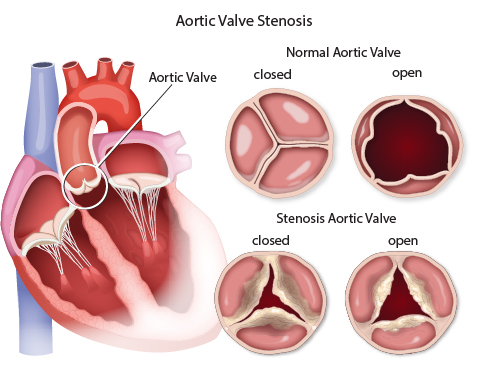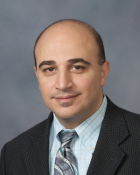 Aortic valve stenosis is one of the most common forms of heart valve disease. However, it is also one of the most serious. If you have aortic valve stenosis, the valve between your heart and the aorta, the large blood vessel that carries blood away from your heart, has narrowed. This means your heart has to work harder to circulate blood throughout your body. As the condition worsens, it can eventually lead to heart failure.
Aortic valve stenosis is one of the most common forms of heart valve disease. However, it is also one of the most serious. If you have aortic valve stenosis, the valve between your heart and the aorta, the large blood vessel that carries blood away from your heart, has narrowed. This means your heart has to work harder to circulate blood throughout your body. As the condition worsens, it can eventually lead to heart failure.
At UK Gill Heart & Vascular Institute, the structural heart program team provides Kentuckians with leading-edge treatments. These treatments are designed to help patients with aortic valve stenosis lead their best lives.
It’s possible to have aortic valve stenosis for years without having any symptoms. This is because the disease progresses slowly, and symptoms sometimes don’t occur until the narrowing of the valve has considerably worsened.
When symptoms of aortic valve stenosis occur, they can include:
- Chest pain
- Dizziness or lightheadedness
- Inability to perform regular activities or walk short distances
- Rapid heartbeat or a feeling of fluttering in your chest
- Shortness of breath, especially when active
- Swollen feet or ankles
- Trouble sleeping or having to sleep in a sitting position
Symptoms often occur during exercise because the heart must work harder to compensate for the narrow valve opening. This also causes the left ventricle of the heart to thicken over time and occupy more space in the lower heart chamber. As a result, your heart may not circulate enough blood. Eventually, this can lead to heart failure.
Aortic stenosis is most common in older people. It is caused by calcium buildup in the heart valve. Valve problems usually begin after age 60 but often don’t cause symptoms until age 70 or older.
In young people, aortic stenosis can happen due to a heart defect called bicuspid aortic valve, in which only two cusps grow instead of three, as normal. Bicuspid aortic valve can also occur when the valve opening fails to grow along with the rest of the heart, which can lead to restricted blood flow throughout the body. Having rheumatic fever can also damage the valve and cause aortic stenosis to develop.
Your first visit to the structural heart program at the UK Gill Heart & Vascular Institute will be a meeting that often takes only an hour. During this appointment, you will meet your care team, including:
- Your interventional cardiologist, a specialist who uses catheter-based procedures to diagnose and treat heart issues
- An advanced practice provider, (a physician assistant or nurse practitioner)
- A nurse coordinator
- A patient navigator, who works with you to help ensure that your healthcare needs are met
If you need imaging, you will be scheduled for a follow-up visit at this time.
For the visit:
- Wear comfortable clothing.
- Bring your insurance information. While UK HealthCare accepts all insurers, not every insurer is in network.
- Bring a list of all medicines and supplements you currently take.
- You may find it helpful to have a family member or friend with you at this visit.
Where we are located
The UK Gill Heart & Vascular Institute is located at 800 Rose St. in Pavilion G, on the first floor of UK Albert B. Chandler Hospital. We will mail you a map and directions when your appointment is scheduled.
Patient drop-off
Patients can be dropped off in front of the main entrance to Albert B. Chandler Hospital at 1000 S. Limestone. If you are dropped off at the main entrance, you’ll enter the revolving doors on the ground floor of the hospital. Take the main stairs just to the left (or elevator across the atrium) to the first floor of Pavilion A.
After climbing the stairs or taking the elevator, turn left. You’ll pass the Kentucky Wall and Kentucky Children’s Hospital on your right. Continue to the end of the hall until it comes to a T shape. Turn left and the Gill clinic entrance is across from an open area housing the organ donor wall.
Parking
It is easiest to park in the UK HealthCare Parking Garage, across from the hospital at 110 Transcript Ave.
There are two paths from this garage to the Gill clinic:
- You may take the free shuttle from Level A of the parking garage. You’ll exit the shuttle at the Pavilion A/ Pavilion G stop in front of the main entrance to the hospital. After climbing the stairs or taking the elevator, turn left. You’ll pass the Kentucky Wall and Kentucky Children’s Hospital on your right. Continue to the end of the hall until it comes to a T shape. Turn left and the Gill clinic entrance is across from an open area housing the organ donor wall.
- From Level C of the parking garage you may walk or take a golf cart across the pedway to the first floor of Pavilion A. Turn left past the help desk and walk away from the dining hall. You’ll pass the Kentucky Wall and Kentucky Children’s Hospital on your right. Continue to the end of the hall until it comes to a T shape. Turn left and the Gill clinic entrance is across from an open area housing the organ donor wall.
If you need help finding your way, information desks are located inside the main entrances to Pavilion A, both on the ground floor and at the end of the pedway on the first floor. You may also call the information desk at 859-323-5816.
The UK Gill Heart & Vascular Institute’s structural heart program offers patients access to advanced clinical trials. Our Cardiology Clinical Research Center gives structural heart disease patients a chance to try new technologies years before they are available to the general public. These innovative and potentially lifesaving procedures are not available at other facilities in the region.











